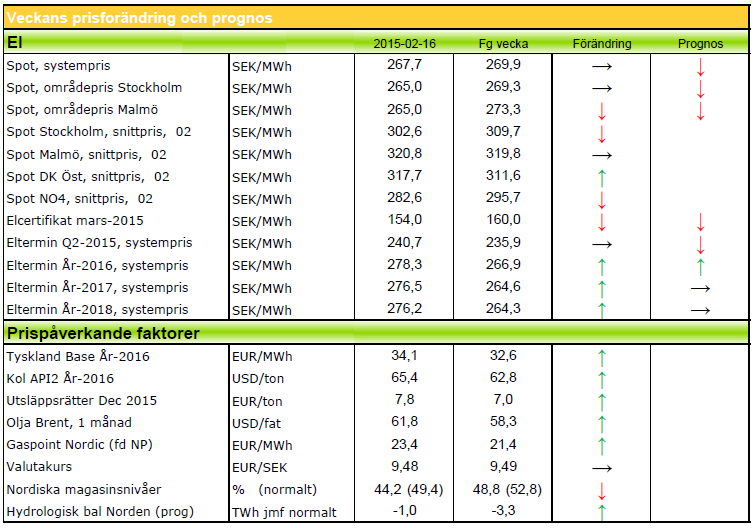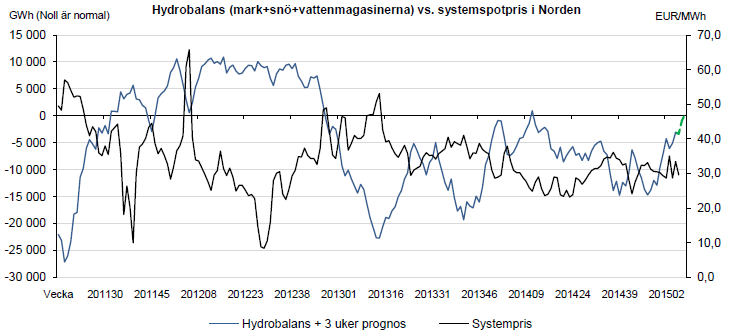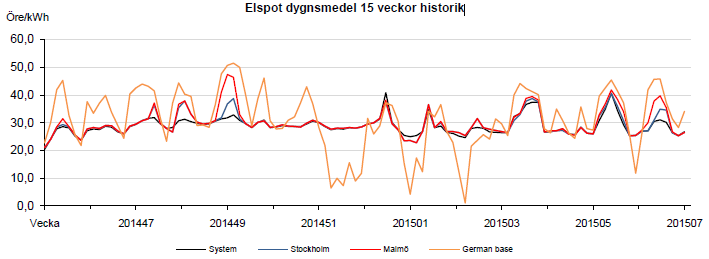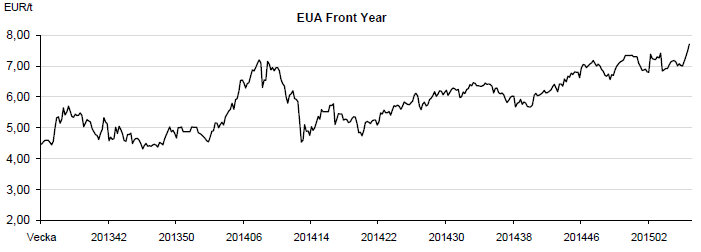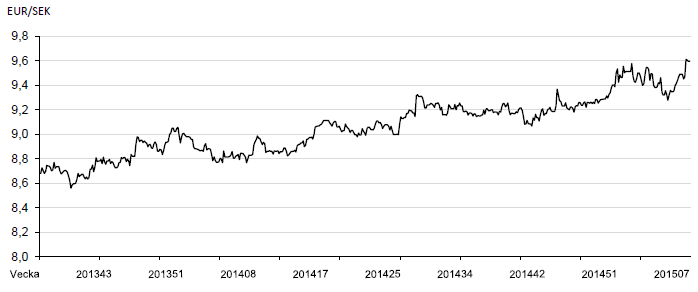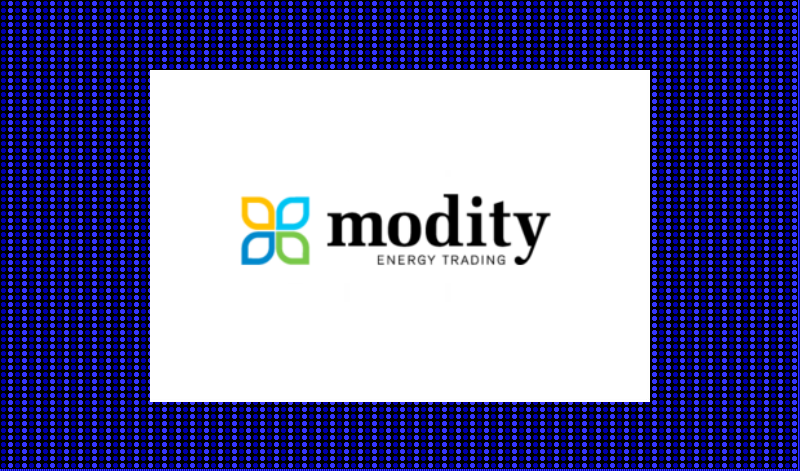Analys
Modity om elpriset vecka 8 2015
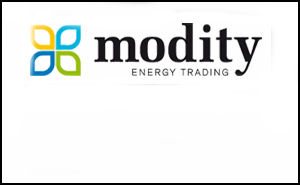
Veckans marknadskommentar
Kol och olja upp och drar med sig de långa elterminerna. Den korta elen är ned på varma, blöta och blåsiga prognoser. Utsläppsrätterna börjar nu stärkas rejält i avvaktan på omröstning. Hydrobalansen är för första gången på länge positiv samt att vi väntar mycket nederbörd den kommande tiodagarsperioden.
Hydrobalansen ligger v06 på 0,7 TWh över normalen. Så mycket nederbörd som det kommit sedan sist! Man pratar om den snörikaste vintern på över 50 år i västra Norge! Det är fortfarande så att prognoserna ser blöta och milda ut så en fortsatt upplagring av energi över normalen verkar det bli!
Kärnkraftverken i Norden har idag den 16/2 en produktion på 73 % (9 031 MW). Ringhals 4 är fortfarande ute för att ordna till läckan. Tillbaka på onsdag. Annars är Oskarshamn 2 kvar ute till september och Ringhals 2 till november. Finska Olkiluoto 2 är fortfarande ur drift – förlängt detta till återstart 18 februari. De finska verken körs därmed 68 %.
Systemspotpriset förra veckan blev 29,61 €/MWh. Det var en tillbakagång på nästan fyra euro. I prisområde SE3 blev den 30,87 och i SE4 33,34. Nu ser vi en ökning i temperaturerna igen och spoten förväntas inte överstiga 30 €/MWh (SYS).
Terminspriser
Förra veckan byttes de överblöta prognoserna ut mot mer måttliga och det fick veckan att visa en uppåtrörelse i både Q2-15 och YR-16. Den senare rätt så kraftigt. Skillnaden terminerna emellan var att Q2:an kom tillbaka lite på fredagen. Det gjorde inte året. Idag har nya prognoser i det närmaste fått Q2 att peka nedåt. Däremot ångar YR-16 på åt andra hållet. Det längre påverkas av andra faktorer än vädret i större grad än det korta. Vi ser högre priser i kol och CO2, vilket ger en starkare långtermin. Q2:an är mycket känsligare för vädret som är just nu och därför drar den nedåt. Omsätts i skrivande stund på 25,10. År 16 handlas nu på 28,90 €/MWh.
Bränslemarknaden
Utsläppsrätter, CO2
Det verkar nu som denna marknad har börjat bli nervös inför omröstningen om en vecka. Räknat från dippen vid förra omröstningen har priset nu stigit från 6,84 €/ton den 22 feb, till 7,83 senast omsatt idag. Lägg därtill att euron stärkts samtidigt så har det blivit kraftigt fördyrat att köpa utsläppsrätter för oss som har annan valuta i botten!
Olja: Brent (FM) har stigit med ca 8 dollar sedan lägstanoteringen i mitten av januari. Uppgången är rätt brant på sistone och det förklaras delvis av att marknader spekulerar för att göra korta vinster. Fundamentalt är det bara det faktum att ytterligare anläggningar stänger ned på grund av priset, som skulle kunna påverka uppåt. Totalt sett är det fortfarande ett tydligt och markant överskott på marknaden, vilket borde öka innan sommaren, när raffinaderierna kör för fullt. Därför kan den nuvarande uppgången vara ytterst instabil.
Kol: Kolet har stigit till drygt 63 dollar/ton. Idag är spreaden ännu högre men omsättningen har inte riktigt vaknat. Även kortare sidan har kommit upp. Stigande oljepriser påverkar förtås – kol och olja går nästan hand i hand i fråga om priser. Fortfarande har vi även på kolet en överproduktion, räknat på världens nuvarande behov.
Naturgas: Förra veckan annonserade man en neddragen gasproduktion i holländska Groningen. Detta till följd av rädsla hos befolkningen att utvinningen skulle orsaka jordskalv. Tydligen är oron mindre nu och priserna har återigen stabiliserat sig, även om det inte är några revolutionerande hopp. I Ukraina ser man positiva följder av den nyligen införda vapenvilan, vilket verkar som en dämpande faktor på priserna.
Elcertifikat
Nedåt igen! Denna gång riktigt ordentligt! Mars -15 stängde i fredags på 154 SEK. Övriga priser: Mars-16 156 SEK och Mars-17 160 SEK.
Valuta
Valutakommentar
Riksbanken sänkte reporäntan till −0,10 procent förra veckan. De kommer att köpa statsobligationer för 10 miljarder och har beredskap att snabbt göra mer. Det finns tecken på att den underliggande inflationen har bottnat men omvärlden är nu mer osäker och det ökar risken för att inflationen inte stiger tillräckligt snabbt för att nå inflationsmålet på 2%. Just det målet är viktigt för pris- och lönebildningen. Kronan reagerade direkt med att försvagas till 9,68 mot euron för att nu handlas på 9,58. Vi ser en stor range mellan 9,30 – 9,70. Mot dollarn nådde vi 8,55 som högst. Vi har nu 11 månader bakom oss med högre bottnar och högre toppar.
Teknisk analys
Teknisk analys Q2-15
Q2 handlades mellan 24,55 och 25,55 €/MWh förra veckan. Just nu handlas den på 25,15, dvs i mitten av föregående veckas range. Vi har numera 6 veckor med fallande toppar på frontkvartalet och vi bedömer att sannolikheten att vi fortsätter ner är stor. Till skillnad från År-16 och kontinentala priser är Q2 det svagaste. Vänder de övriga ner så brukar den som visar mest svaghet innan falla hårdast när alla andra vänder nedåt. Handel över 25,55 innebär att nedåttrenden skulle vara bruten.
Teknisk analys År-16
År-16 handlades mellan 27,95 och 28,84€/MWh förra veckan. Vi har fortsatt en divergens mellan frontkvartalet och årskontraktet då fronten är på en säljsignal medan årskontraktet ger köpsignaler. Kontraktet är nu inne på andra veckan med högre bottnar men på tanke på att frontkvartalet ser ut att vilja handla lägre kallar vi inte det här för en köpsignal den här gången. Vår bedömning är att årskontraktet handlas i en range där toppen är 29,20. På nedsidan förhåller vi oss till 27,95 som utgör en dubbelbotten för År-16.
[box]Denna energimarknadskommentar om elpriset publiceras på Råvarumarknaden.se med tillstånd och i samarbete med Modity Energy Trading.[/box]
Ansvarsfriskrivning
Energimarknadskommentaren har producerats av Modity Energy Trading. Informationen är rapporterad i god tro och speglar de aktuella åsikterna hos medarbetarna, dessa kan ändras utan varsel. Modity Energy Trading tar inget ansvar för handlingar baserade på informationen.
Om Modity Energy Trading
Modity Energy Trading erbjuder energibolag och större företag den erfarenhet, kompetens och analysredskap som krävs för en trygg och effektiv förvaltning av energiportföljen. Modity bedriver handel med allt från el och gas, till elcertifikat, valutor och utsläppsrätter. Företagets kunder får dessutom ta del av deras analysprodukter som t.ex det fullständiga marknadsbrevet med ytterligare kommentarer och prognoser. För ytterligare information se hemsidan.
Analys
OPEC+ will likely unwind 500 kb/d of voluntary quotas in October. But a full unwind of 1.5 mb/d in one go could be in the cards

Down to mid-60ies as Iraq lifts production while Saudi may be tired of voluntary cut frugality. The Brent December contract dropped 1.6% yesterday to USD 66.03/b. This morning it is down another 0.3% to USD 65.8/b. The drop in the price came on the back of the combined news that Iraq has resumed 190 kb/d of production in Kurdistan with exports through Turkey while OPEC+ delegates send signals that the group will unwind the remaining 1.65 mb/d (less the 137 kb/d in October) of voluntary cuts at a pace of 500 kb/d per month pace.

Signals of accelerated unwind and Iraqi increase may be connected. Russia, Kazakhstan and Iraq were main offenders versus the voluntary quotas they had agreed to follow. Russia had a production ’debt’ (cumulative overproduction versus quota) of close to 90 mb in March this year while Kazakhstan had a ’debt’ of about 60 mb and the same for Iraq. This apparently made Saudi Arabia angry this spring. Why should Saudi Arabia hold back if the other voluntary cutters were just freeriding? Thus the sudden rapid unwinding of voluntary cuts. That is at least one angle of explanations for the accelerated unwinding.
If the offenders with production debts then refrained from lifting production as the voluntary cuts were rapidly unwinded, then they could ’pay back’ their ’debts’ as they would under-produce versus the new and steadily higher quotas.
Forget about Kazakhstan. Its production was just too far above the quotas with no hope that the country would hold back production due to cross-ownership of oil assets by international oil companies. But Russia and Iraq should be able to do it.
Iraqi cumulative overproduction versus quotas could reach 85-90 mb in October. Iraq has however steadily continued to overproduce by 3-5 mb per month. In July its new and gradually higher quota came close to equal with a cumulative overproduction of only 0.6 mb that month. In August again however its production had an overshoot of 100 kb/d or 3.1 mb for the month. Its cumulative production debt had then risen to close to 80 mb. We don’t know for September yet. But looking at October we now know that its production will likely average close to 4.5 mb/d due to the revival of 190 kb/d of production in Kurdistan. Its quota however will only be 4.24 mb/d. Its overproduction in October will thus likely be around 250 kb/d above its quota with its production debt rising another 7-8 mb to a total of close to 90 mb.
Again, why should Saudi Arabia be frugal while Iraq is freeriding. Better to get rid of the voluntary quotas as quickly as possible and then start all over with clean sheets.
Unwinding the remaining 1.513 mb/d in one go in October? If OPEC+ unwinds the remaining 1.513 mb/d of voluntary cuts in one big go in October, then Iraq’s quota will be around 4.4 mb/d for October versus its likely production of close to 4.5 mb/d for the coming month..
OPEC+ should thus unwind the remaining 1.513 mb/d (1.65 – 0.137 mb/d) in one go for October in order for the quota of Iraq to be able to keep track with Iraq’s actual production increase.
October 5 will show how it plays out. But a quota unwind of at least 500 kb/d for Oct seems likely. An overall increase of at least 500 kb/d in the voluntary quota for October looks likely. But it could be the whole 1.513 mb/d in one go. If the increase in the quota is ’only’ 500 kb/d then Iraqi cumulative production will still rise by 5.7 mb to a total of 85 mb in October.
Iraqi production debt versus quotas will likely rise by 5.7 mb in October if OPEC+ only lifts the overall quota by 500 kb/d in October. Here assuming historical production debt did not rise in September. That Iraq lifts its production by 190 kb/d in October to 4.47 mb/d (August level + 190 kb/d) and that OPEC+ unwinds 500 kb/d of the remining quotas in October when they decide on this on 5 October.
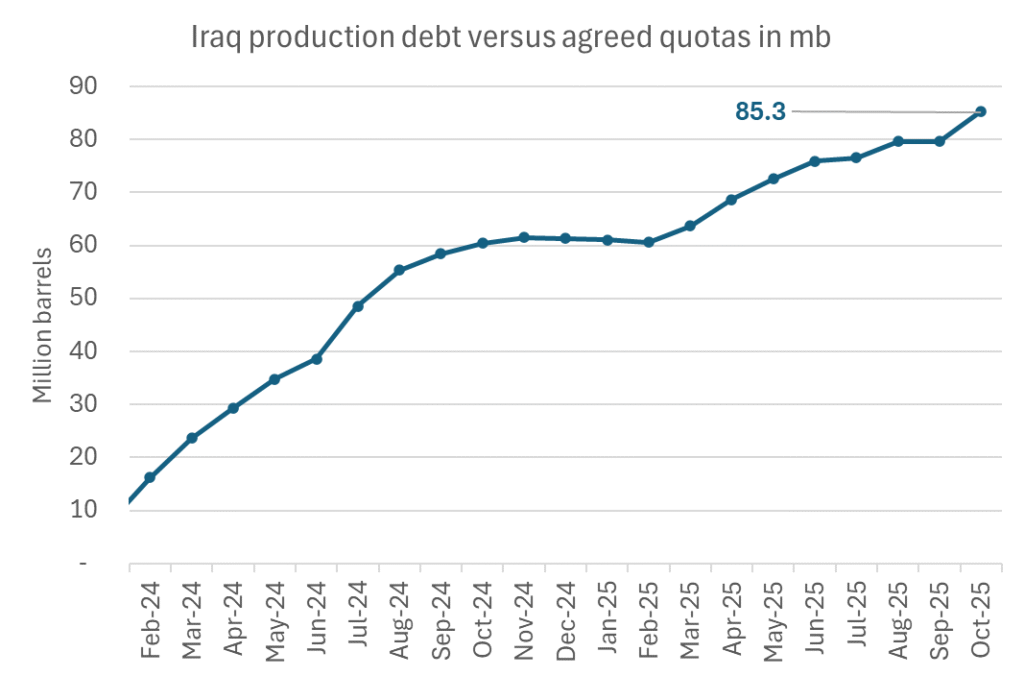
Analys
Modest draws, flat demand, and diesel back in focus

U.S. commercial crude inventories posted a marginal draw last week, falling by 0.6 million barrels to 414.8 million barrels. Inventories remain 4% below the five-year seasonal average, but the draw is far smaller than last week’s massive 9.3-million-barrel decline. Higher crude imports (+803,000 bl d WoW) and steady refinery runs (93% utilization) helped keep the crude balance relatively neutral.

Yet another drawdown indicates commercial crude inventories continue to trend below the 2015–2022 seasonal norm (~440 million barrels), though at 414.8 million barrels, levels are now almost exactly in line with both the 2023 and 2024 trajectory, suggesting stable YoY conditions (see page 3 attached).
Gasoline inventories dropped by 1.1 million barrels and are now 2% below the five-year average. The decline was broad-based, with both finished gasoline and blending components falling, indicating lower output and resilient end-user demand as we enter the shoulder season post-summer (see page 6 attached).
On the diesel side, distillate inventories declined by 1.7 million barrels, snapping a two-week streak of strong builds. At 125 million barrels, diesel inventories are once again 8% below the five-year average and trending near the low end of the historical range.
In total, commercial petroleum inventories (excl. SPR) slipped by 0.5 million barrels on the week to ish 1,281.5 million barrels. While essentially flat, this ends a two-week streak of meaningful builds, reflecting a return to a slightly tighter situation.
On the demand side, the DOE’s ‘products supplied’ metric (see page 6 attached), a proxy for implied consumption, softened slightly. Total demand for crude oil over the past four weeks averaged 20.5 million barrels per day, up just 0.9% YoY.
Summing up: This week’s report shows a re-tightening in diesel supply and modest draws across the board, while demand growth is beginning to flatten. Inventories remain structurally low, but the tone is less bullish than in recent weeks.
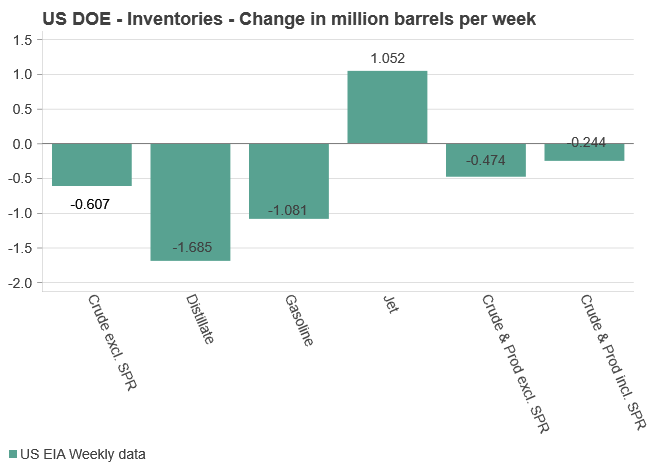
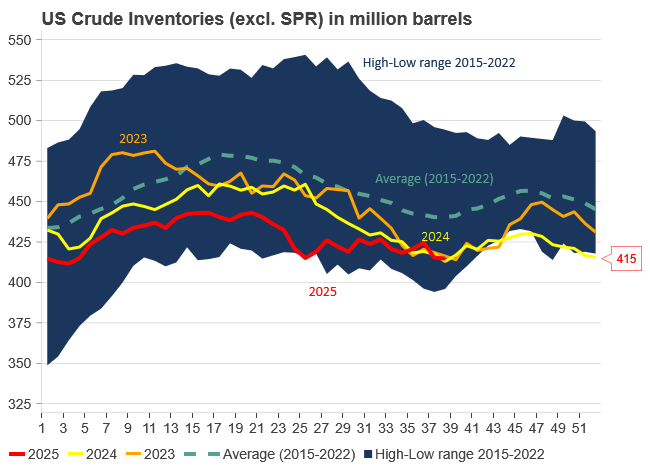
Analys
Are Ukraine’s attacks on Russian energy infrastructure working?

Brent crude rose 1.6% yesterday. After trading in a range of USD 66.1 – 68.09/b it settled at USD 67.63/b. A level which we are well accustomed to see Brent crude flipping around since late August. This morning it is trading 0.5% higher at USD 68/b. The market was expecting an increase of 230 kb/d in Iraqi crude exports from Kurdistan through Turkey to the Cheyhan port but that has so far failed to materialize. This probably helped to drive Brent crude higher yesterday. Indications last evening that US crude oil inventories likely fell 3.8 mb last week (indicative numbers by API) probably also added some strength to Brent crude late in the session. The market continues to await the much heralded global surplus materializing as rising crude and product inventories in OECD countries in general and the US specifically.

The oil market is starting to focus increasingly on the successful Ukrainian attacks on Russian oil infrastructure. Especially the attacks on Russian refineries. Refineries are highly complex and much harder to repair than simple crude oil facilities like export pipelines, ports and hubs. It can take months and months to repair complex refineries. It is thus mainly Russian oil products which will be hurt by this. First oil product exports will go down, thereafter Russia will have to ration oil product consumption domestically. Russian crude exports may not be hurt as much. Its crude exports could actually go up as its capacity to process crude goes down. SEB’s Emerging Market strategist Erik Meyersson wrote about the Ukrainian campaign this morning: ”Are Ukraine’s attacks on Russian energy infrastructure working?”. Phillips P O’Brian published an interesting not on this as well yesterday: ”An Update On The Ukrainian Campaign Against Russian Refineries”. It is a pay-for article, but it is well worth reading. Amongst other things it highlights the strategic focus of Ukraine towards Russia’s energy infrastructure. A Ukrainian on the matter also put out a visual representation of the attacks on twitter. We have not verified the data representation. It needs to be interpreted with caution in terms of magnitude of impact and current outage.
Complex Russian oil refineries are sitting ducks in the new, modern long-range drone war. Ukraine is building a range of new weapons as well according to O’Brian. The problem with attacks on Russian refineries is thus on the rise. This will likely be an escalating problem for Russia. And oil products around the world may rise versus the crude oil price while the crude oil price itself may not rise all that much due to this.
Russian clean oil product exports as presented by SEB’s Erik Meyersson in his note this morning.
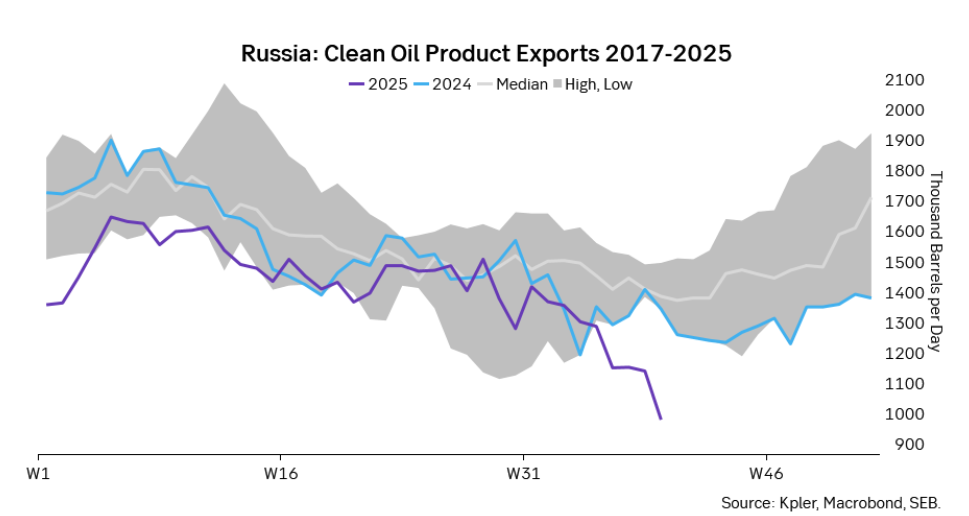
The ICE Gasoil crack and the 3.5% fuel oil crack has been strengthening. The 3.5% crack should have weakened along with rising exports of sour crude from OPEC+, but it hasn’t. Rather it has moved higher instead. The higher cracks could in part be due to the Ukrainian attacks on Russian oil refineries.
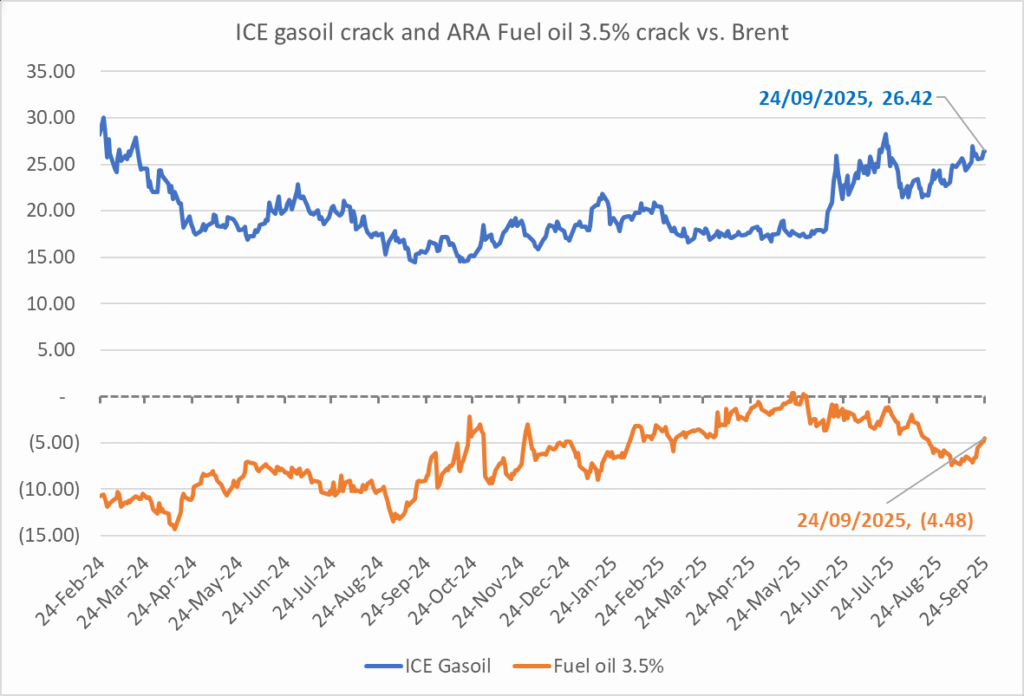
Ukrainian inhabitants graphical representation of Ukrainian attacks on Russian oil refineries on Twitter. Highlighting date of attacks, size of refineries and distance from Ukraine. We have not verified the detailed information. And you cannot derive the amount of outage as a consequence of this.

-

 Nyheter4 veckor sedan
Nyheter4 veckor sedanEurobattery Minerals satsar på kritiska metaller för Europas självförsörjning
-

 Nyheter3 veckor sedan
Nyheter3 veckor sedanMahvie Minerals i en guldtrend
-

 Nyheter4 veckor sedan
Nyheter4 veckor sedanGuldpriset kan närma sig 5000 USD om centralbankens oberoende skadas
-

 Nyheter4 veckor sedan
Nyheter4 veckor sedanOPEC signalerar att de inte bryr sig om oljepriset faller kommande månader
-

 Analys3 veckor sedan
Analys3 veckor sedanVolatile but going nowhere. Brent crude circles USD 66 as market weighs surplus vs risk
-
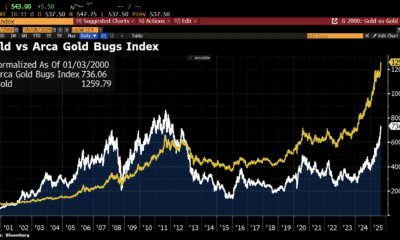
 Nyheter3 veckor sedan
Nyheter3 veckor sedanAktier i guldbolag laggar priset på guld
-

 Nyheter3 veckor sedan
Nyheter3 veckor sedanKinas elproduktion slog nytt rekord i augusti, vilket även kolkraft gjorde
-

 Nyheter2 veckor sedan
Nyheter2 veckor sedanTyskland har så höga elpriser att företag inte har råd att använda elektricitet


